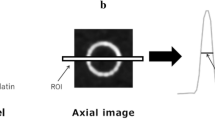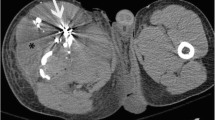Abstract
Objective
This paper evaluates a prototype flat-panel volume CT (fpVCT) for dynamic in vivo imaging in a variety of neurovascular and lower limb applications.
Methods
Dynamic CTA was performed on 12 patients (neuro = 8, lower limb = 4) using an fpVCT with 120 kVp, 50 mA, rotation time varying from 8 to 19 s, and field of view of 25 × 25 × 18 cm3. Four-dimensional data sets (i.e. 3D images over time) were reconstructed and reviewed.
Results
Dynamic CTA demonstrated sufficient spatio-temporal resolution to elucidate first-pass and recirculation dynamics of contrast bolus through neurovasclaur pathologies and phasic blood flow though lower-limb vasculature and grafts. The high spatial resolution of fpVCT resulted in reduced partial volume and metal beam-hardening artefacts. This facilitated assessment of vascular lumen in the presence of calcified plaque and evaluation of fractures, especially in the presence of fixation hardware. Evaluation of arteriovenous malformation using dynamic fpVCT angiography was of limited utility.
Conclusions
Dynamic CTA using fpVCT can visualize time-varying phenomena in neuro and lower limb vascular applications and has suffcient diagnostic imaging quality to evaluate a number of pathologies affecting these regions.
Key Points
• CTA using fpVCT has sufficient spatial and temporal resolution to study phasic blood flow.
• CTA using fpVCT reveals recurrence of aneurysms even after clipping/coiling.
• fpVCT has reduced partial volume and metal beam-hardening artefacts.
• fpVCT can show vessel lumen in the presence of calcified plaque.
• CTA using fpVCT can demonstrate vascular supply to transplanted grafts.






Similar content being viewed by others
Abbreviations
- CTA:
-
CT angiogram
- DSA:
-
Digital subtraction angiography
- fpVCT:
-
Flat-panel volume CT
- MDCT:
-
Multi-detector computer-assisted tomography
References
Konstas AA, Goldmakher GV, Lee T-Y, Lev MH (2009) Theoretic basis and technical implementations of CT perfusion in acute ischemic stroke, part 2: technical implementations. AJNR Am J Neuroradiol 30:885–892
Gupta R, Mani S, Mehndiratta A et al (2011) In: Law M, Som PM, Naidich TP (eds) Multi-detector computed tomography as a problem solving tool in neuroradiology. Problem solving in neuroradiology. Saunders, Philadelphia
Gupta R, Mehndiratta A, Mitha AP et al (2011) Temporal resolution of dynamic angiography using flat panel volume CT: in vivo evaluation of time-dependent vascular pathologies. AJNR Am J Neuroradiol 32:1688–1696
Mitha AP, Reichardt B, Grasruck M et al (2009) Dynamic imaging of a model of intracranial saccular aneurysms using ultra-high-resolution flat-panel volumetric computed tomography. Laboratory investigation. J Neurosurg 111:947–957
Gupta R, Grasruck M, Suess C et al (2006) Ultra-high resolution flat-panel volume CT: fundamental principles, design architecture, and system characterization. Eur Radiol 16:1191–1205
Bartling S, Kuntz J, Mehndiratta A et al (2012) Prior image constrained compressed sensing (PICCS) on a flat-panel cone-beam CT: a new method for low dose, 4D human angiography. Radiol Soc N Am, pp SSQ19–09
Feldkamp LA, Davis LC, Kress JW (1984) Practical cone-beam algorithm. J Opt Soc Am 1:612–619
Grasruck M, Suess C, Stierstorfer K et al (2005) Evaluation of image quality and dose on a flat-panel CT-scanner. Proc SPIE 5745:179–188
Shrimpton PC, Hillier MC, Lewis MA, Dunn M (2006) National survey of doses from CT in the UK: 2003. Br J Radiol 79:968–980
Jessen K, Panzer W, Shrimpton P et al (2000) EUR 16262: European guidelines on quality criteria for computed tomography. Office for Official Publications of the European Communities, Luxembourg
Ikram S, Leesar M, Fahsah I (2009) Peripheral angiography. In: Dieter RS, Dieter RA III, Dieter RA Jr (eds) Peripheral artery disease, 1st edn. McGraw-Hill, New York, pp 341–373
Grzyska U, Freitag J, Zeumer H (1990) Selective cerebral intraarterial DSA. Complication rate and control of risk factors. Neuroradiology 32:296–299
Agid R, Willinsky RA, Lee S-K et al (2008) Characterization of aneurysm remnants after endovascular treatment: contrast-enhanced MR angiography versus catheter digital subtraction angiography. AJNR Am J Neuroradiol 29:1570–1574
Reichardt B, Sarwar A, Bartling SH et al (2008) Musculoskeletal applications of flat-panel volume CT. Skeletal Radiol 37:1069–1076
Cheung AC, Bredella MA, Al Khalaf M et al (2009) Reproducibility of trabecular structure analysis using flat-panel volume computed tomography. Skeletal Radiol 38:1003–1008
Phan CM, Macklin EA, Bredella MA et al (2011) Trabecular structure analysis using C-arm CT: comparison with MDCT and flat-panel volume CT. Skeletal Radiol 40:1065–1072
Fritzsche SD (2001) Comorbid risk factors in TRAM flap failure. Plast Surg Nurs 21:178, 181–183; quiz 184
Molina AR, Jones ME, Hazari A et al (2012) Correlating the deep inferior epigastric artery branching pattern with type of abdominal free flap performed in a series of 145 breast reconstruction patients. Ann R Coll Surg Engl 94:493–495
Sbitany H, Mirzabeigi MN, Kovach SJ et al (2012) Strategies for recognizing and managing intraoperative venous congestion in abdominally based autologous breast reconstruction. Plast Reconstr Surg 129:809–815
Scheufler O, Exner K, Andresen R (2004) Investigation of TRAM flap oxygenation and perfusion by near-infrared reflection spectroscopy and color-coded duplex sonography. Plast Reconstr Surg 113:141–152, discussion 153–155
Acknowledgements
We want to thank Drs. B.H. Sapkota, C. Phan, and S. Iqbal for their help in patient recruitment and scanning, Dr. C. Leidecker for technical support, and Ms. J. Miller for proofreading this paper.
The scientific guarantor of this publication is Dr. Rajiv Gupta, Radiology, MGH, Boston. R. Gupta’s research was partially supported by a research grant from Siemens Healthcare (MGH-2010-CT-35702), Defense Advanced Research Projects Agency (N66001-11-1-4204), and US Army Medical Research Acquisitions (W81XWH-09-2-0001). Michael Grasruck is an employee at Siemens Healthcare, Forchheim, Germany. Amit Mehndiratta, James D. Rabinov, Eric C. Liao, and David Crandell declare no relationships with any companies whose products or services may be related to the subject matter of the article. The authors state that this work has not received any funding. No complex statistical methods were necessary for this paper. Institutional review board approval was obtained. Written informed consent was obtained from all subjects (patients) in this study. Methodology: prospective, diagnostic or prognostic study, performed at one institution.
Author information
Authors and Affiliations
Corresponding author
Rights and permissions
About this article
Cite this article
Mehndiratta, A., Rabinov, J.D., Grasruck, M. et al. High-resolution dynamic angiography using flat-panel volume CT: feasibility demonstration for neuro and lower limb vascular applications. Eur Radiol 25, 1901–1910 (2015). https://doi.org/10.1007/s00330-015-3612-8
Received:
Revised:
Accepted:
Published:
Issue Date:
DOI: https://doi.org/10.1007/s00330-015-3612-8




